SaaS SEO Guide
SaaS SEO : The #1 Guide to Growing Your SaaS Business in 2023
Book a FREE SEO Strategy Consultation >
Further Reading:
00. Introduction
Software as a Service (SaaS) is a rapidly evolving industry that has truly taken the world by storm. But of course, with exponential growth, comes fierce competition. If you are a SaaS business wanting to stand out in this highly-saturated marketplace, you will not only need to keep up with your rivals, but stay ahead of them. How do you do this? By creating a robust SaaS SEO strategy.
An effective strategy, whether developed in-house or through a professional SaaS SEO agency, is vital to achieving sustainable growth and success in the SaaS market.
This step-by-step guide will walk you through the process of creating a tailored SEO strategy for your SaaS business – the very thing that will set you apart from the rest of the competition.
01. Does SEO Still Work in 2023?
Yes! Search Engine Optimisation is still very much a relevant and effective strategy in 2023. Whilst algorithms, market trends and best practices may evolve over time, the core principles of SEO remain unchanged.
A recent report by Brightedge found that 68% of online experiences begin with a search engine, but only 0.63% of those searchers will go beyond the first page of Google’s search engine result. Because of this, it is absolutely integral that businesses continue to implement SEO strategies. SEO for SaaS companies is especially important, given it is so vital to stay relevant and ahead of the game within the industry.
Implementing a comprehensive SEO strategy that includes creating high-quality, helpful content, optimizing for relevant keywords and acquiring backlinks, can significantly enhance a website’s chance of increasing visibility and driving organic traffic. Just keep in mind, to ensure your strategy is up-to-date and effective in the present day, you will need to stay informed with the latest news, updates and trends when it comes to algorithms and best-practices. Once you do this, you will be well on your way to nailing SEO for your SaaS company.
02. The Importance of SEO Strategies for SaaS Business Success
Let’s start with a quick refresher on SEO. SEO is a catch-all for everything you do to improve your brand’s performance on search engine results pages (SERPs). The aim is to get your landing pages, blog content, and products as high on those pages as possible. The higher ranked you are, after all, the more traffic you get.

There are a vast number of factors that go into determining each page’s ranking. Google – the pre-eminent search engine – uses an AI-enhanced algorithm to rank online material. Some of the ranking factors accounted for by the algorithm include:
- User engagement – How site visitors interact with your pages. How much time are they spending on your site? How much do they click on or engage with your content? How often do your pages get viewed?
- Link profile – The makeup of the links to and from your content. Which sites and domains link to you? Where do your external links lead? How are internal links organized?
- Content – What your onsite material is about and how useful it is. What keywords are prominent within your onsite content? How well do articles or posts answer reader intent?
- Domain authority – How relevant is the content to your specific industry? Google evaluates your business on Expertise, Authorativeness, and Trustworthiness now more than ever before. Does your site include a thorough about page? Have you provided the site visitor with easy-to-find contact pages and references and external links to sources? Does every article on your blog feature author bylines?
Those represent the tip of the ranking factor iceberg. A robust SaaS SEO strategy accounts for all of them and more. It’s not a simple feat; it takes significant time, effort, and investment. Done well, however, and it’s all worth it for a range of reasons.
1. Predictable & scalable growth.
Like many acquisition channels, SEO is complicated. Plenty goes into making it work efficiently for your brand. Unlike things such as pay per click (PPC) advertising or incentive marketing, though, it’s often predictable.
The precise volume of organic traffic any site gets will differ. No two pages or posts are the same. Trends and patterns in search traffic, however, are broadly predictable. With proper analytics and experience on your side, you can anticipate the results of your SEO actions.
It’s comparatively straightforward, for instance, to foresee the boost in traffic that will come if you move from moving from the second page to the first page of results for search term. That makes it easier to assess ROI and budget for a long-term SEO strategy.
Weekly Organic Traffic

What’s more, growing traffic via SEO can deliver exponential results. As you ramp up and improve your efforts, the impact compounds. Everything you do builds upon the actions you’ve already taken. That means each improvement’s effect is more significant than if that was the only step you’d made.
2. Standing out.
Did you know that in the last seven years, the SaaS industry has grown by approximately 500%? In 2021, the market was worth roughly 146 billion dollars, but this year, it’s expected to reach 195 billion dollars.
It’s pretty clear that SaaS is only gaining in value. That means it’s a lucrative industry, which tells us that A: it’s a good industry to get involved in, and B: it’s bound to be highly competitive.
So how can you stand out among other SaaS sites?
The answer is simpler than it seems. Even the best content strategy alone won’t automatically make your software look more appealing than your competitors’ – unless those competitors are on page 2 of Google’s search results. In other words, the secret lies in adopting an all-encompassing SEO plan.
SEO’s popularity is on the rise, meaning that the search volume for your target keywords is going up. By getting some help from a professional saas seo agency – who can offer a range of SaaS SEO services, your business can get in on those organic searches.
SEO isn’t just about throwing some keywords into your content. It involves bringing together engaging content, efficient web design, keyword research, link building, and data analytics to produce an optimized web presence for your business. Only a combination of these on-page, off-page and technical SEO strategies will help you stand out in such a crowded market.
To truly enhance the value of SEO for SaaS companies, it’s essential to allocate a significant portion of your marketing budget to it. By teaming up with a professional SaaS SEO agency, you can take advantage of a range of SEO services to optimize your web presence and generate targeted organic traffic. In a highly competitive industry like SaaS, an all-encompassing SEO plan that includes engaging content, efficient web design, keyword research, link building, and data analytics is crucial.
3. Supporting & bolstering other channels.
So far, we’ve expounded the virtues of robust SEO. That’s not to say, however, that you should shun all other acquisition strategies. You need a well-rounded plan to find, qualify, nurture, and convert leads. The beauty of an SEO campaign is that it can be the pivot around which such a plan is built.
Boosting organic traffic feeds into and supports your other acquisition and SaaS marketing SEO efforts. More site visitors means more chance of capturing email addresses. That will improve the results of your email marketing.
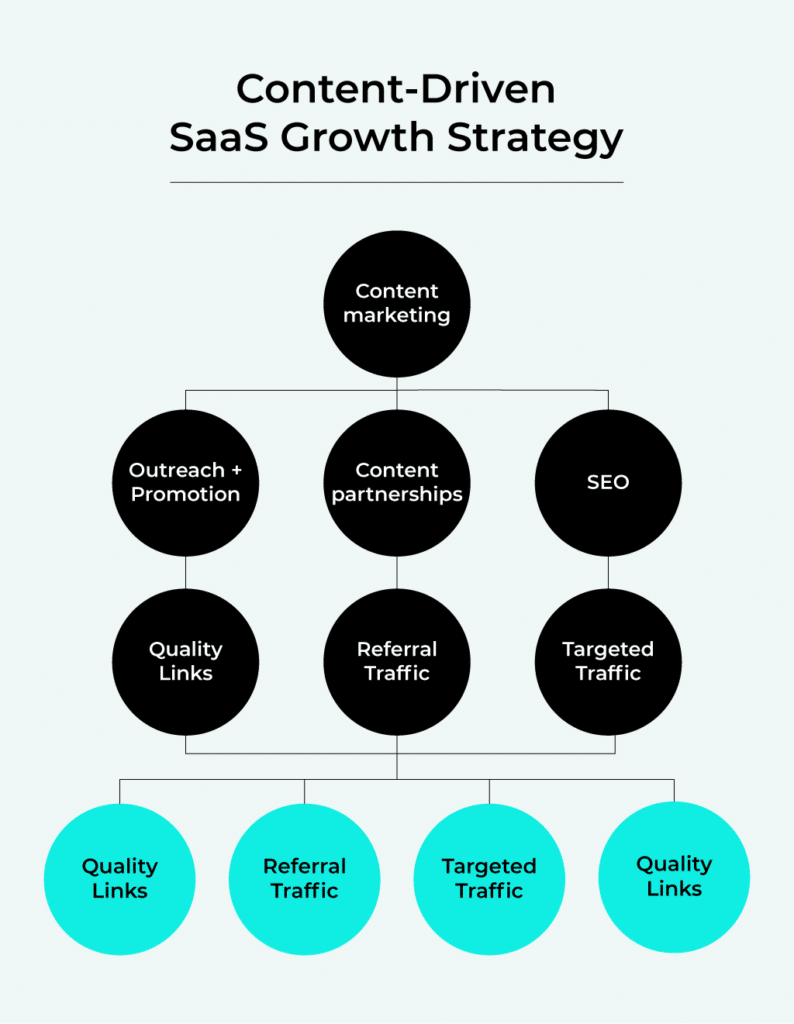
The high-quality content you produce as part of your SEO efforts, too, can be multi-functional. A great blog post is something your digital marketing team can share with your social media followers. A highly optimized product page, meanwhile, will aid your conversion rate optimization (CRO) as well as your SEO.
4. Improving customer relationships.
The goal of all software companies – whether they’re startups, small businesses, or large enterprises – is to make the user experience as smooth as it can be. That includes SaaS companies.
When you’re improving your website for SaaS, you’ll be optimizing all your content. Among other things, that involves making your content easier to find and more informational. And when that happens, your target audience gets easier access to the tips they need to use your software to its maximum potential.
5. Long-term cost-efficiency.
If you’re not yet convinced of the virtues of SEO for SaaS, cost might be the reason. You may be thinking that what goes into growing organic traffic sounds like it needs a lot of investment. It does, but it’s worth it.
Thanks to the aforementioned compound impact of SEO, too, your ROI increases over time. Your first SEO efforts will be slow to take hold. It takes more than your first piece of outstanding content to sway Google. With each step you take, though, the cost of bumping up traffic decreases.
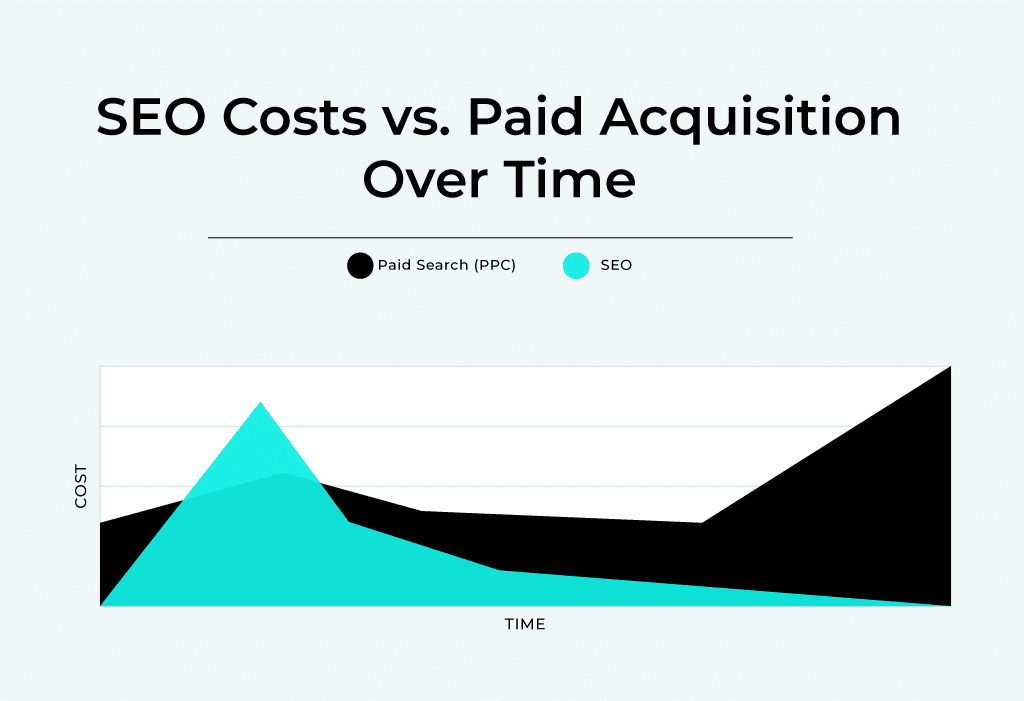
That’s in stark contrast to other acquisition channels. Take PPC, for instance. At first, you may find some low hanging fruit. You could buy ads for some high volume, low competition keywords, and cash in.
As time goes on, though, those opportunities dry up. To keep making gains, you’d have to plunge more and more cash into more competitive ads. What’s more, what you’ve spent in the past is no longer getting you anything. There’s no compound effect like with SEO. Approaching acquisition in this way isn’t sustainable.
It should be apparent, then, why a successful SEO strategy is integral to growth and success. How, though, can you build such a plan? It starts with determining the scale of your SaaS business.
03. Tailoring your Strategy: SEO for SaaS Startups vs. Enterprise Companies
When developing your SaaS SEO strategy, it’s important to consider the scale of your business. The size of your company, the resources you have available, and your target audience are all factors that will have a significant effect on the type of strategy that will be most effective.
As a SaaS startup, you may have a smaller budget and a smaller target audience, so your SEO strategy may need to be more localized and cost-effective. Additionally, building brand awareness and establishing an online presence will be crucial.
On the other hand, enterprise SaaS businesses, which are typically larger in scale, have more resources available and may need to invest in advanced and comprehensive SEO tactics to reach a larger target audience in a highly competitive market.
Ultimately, considering the stage and scale of your SaaS business will allow you to tailor your SEO strategy to maximize results and achieve your personal business objectives. But what’s the first step to building all kinds of SEO strategies? Understanding search intent.
04. Mastering Search Intent: Types of Google Searches
Performing a Google search is something with which we’re all familiar. It’s so run of the mill, in fact, that it’s easy to take it for granted. If you’re already interested in SEO, you won’t fall into that trap, as organic searches are key to your strategy. What you might do, though, is get so caught up with searches that you forget about searchers.
There’s a real person behind every search query, and you should never forget it. Thinking about search volume, keywords, and click-through rates is essential. What’s equally so, is considering and understanding why someone performs the search they do. That’s search intent.
Anyone who types a phrase into Google needs something. They’re looking to the search engine to perform a service on their behalf. Precisely what they need differs, as we’ll cover in a moment. That it’s critical for you to understand their search intent remains the same.
It’s thanks to Google itself that search intent is so vital. The search engine is dedicated to delivering the most relevant results possible. As such, Google’s algorithms can and do recognize the intent behind searches. SERPs only display what searchers want – and need – to see.
Your content marketing strategy needs to factor this in. That means tailoring pages and content to what those searching for relevant SaaS keywords are after. The first step in this process is to grasp the four principal types of search intent:
1. Informational
Sometimes we head to Google to find some answers. We’re looking for information we don’t presently have. This may be a straightforward query like ‘What is VoIP?’.
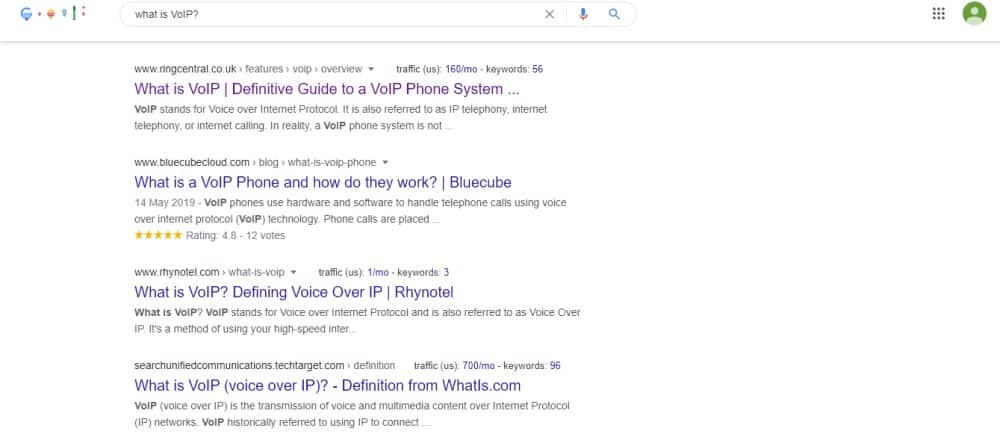
2. Navigational
Sometimes when you perform a search, you know precisely where you want to go. What you might not have is the relevant homepage URL. Or perhaps it’s faster to tap out a quick search than to input it in the address bar.
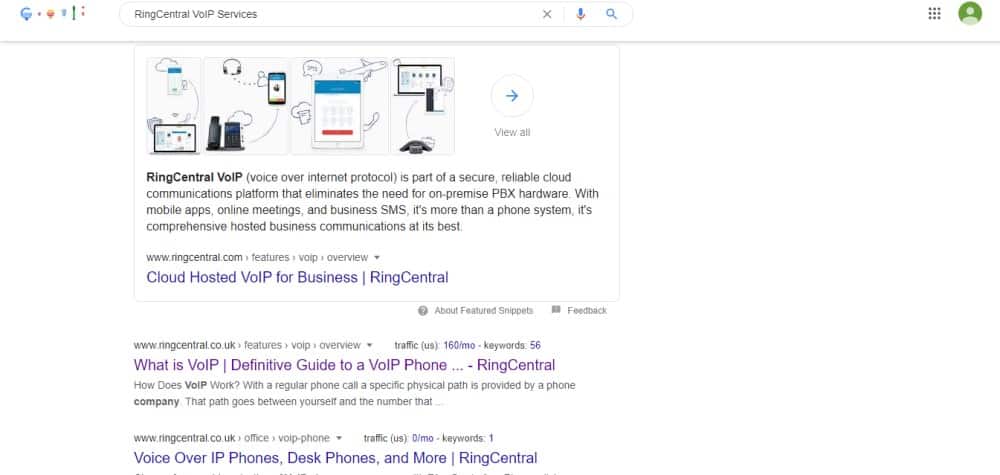
3. Transactional
Among other things, the internet is a vast marketplace. Plenty of searchers on Google are looking to buy something. More than that, some of them are already close to the point of purchase.

4. Investigational
Investigational searches are like a combination of informational and transactional ones. They get performed by people who know they want a product but haven’t decided who from.

‘Vs.’ searches are by far the most common here. Searchers type something like ‘RingCentral vs. Vonage’ to compare the two companies. It’s part of their due diligence on two providers of similar solutions. Marketers should take advantage of this, and make sure their SaaS website shows why they’re the best choice.
Our whistle-stop tour of search intent should have taught you two things. One is that not every searcher is using Google for the same reason. The other is that the type of content that ranks changes according to search intent.
Take a look back at our search intent screenshots. Each one shows separate entries ranking on page one of the SERPs. That’s despite each search term being broadly related to the same topic (VoIP). Grasping search intent, as well as the search terms used, therefore, is critical.
05. Navigating the Funnel: The Importance of SaaS Keyword Research
Learning about search intent is all very well, but what does it have to do with SaaS SEO? That’s a valid question. The answer becomes apparent when you consider the first step to building your SaaS SEO strategy. It’s not performing keyword research, as you might guess. Instead, it’s turning the spotlight on your customers.
You’re likely familiar with the concept of a marketing funnel. For SaaS companies, they usually look something like this:
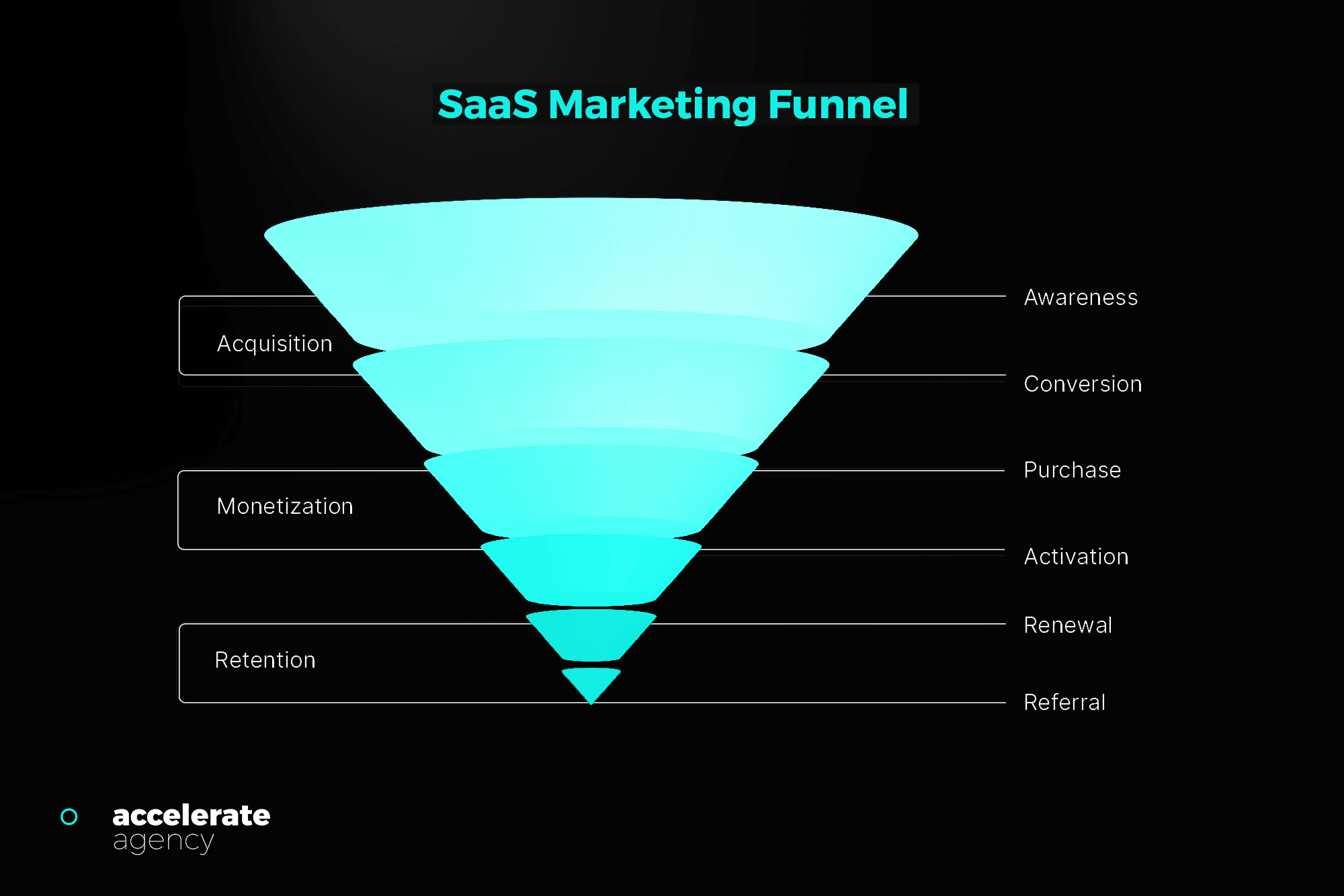
One of the principal aims of a SaaS brand is to get people into – and moving down – their funnel. Once clients reach the ‘Retention’ area, they’re making the company money. It’s there, therefore, that you want to keep customers for as long as possible.
When it comes to SaaS SEO, the ‘Retention’ section is less important. It’s also worthwhile to reimagine the rest of the funnel somewhat. Don’t think of it as a solid funnel with one opening at the top. Rather, imagine a kind of upturned colander. There are access points on every marketing channel, letting customers enter it all the way from top to bottom.
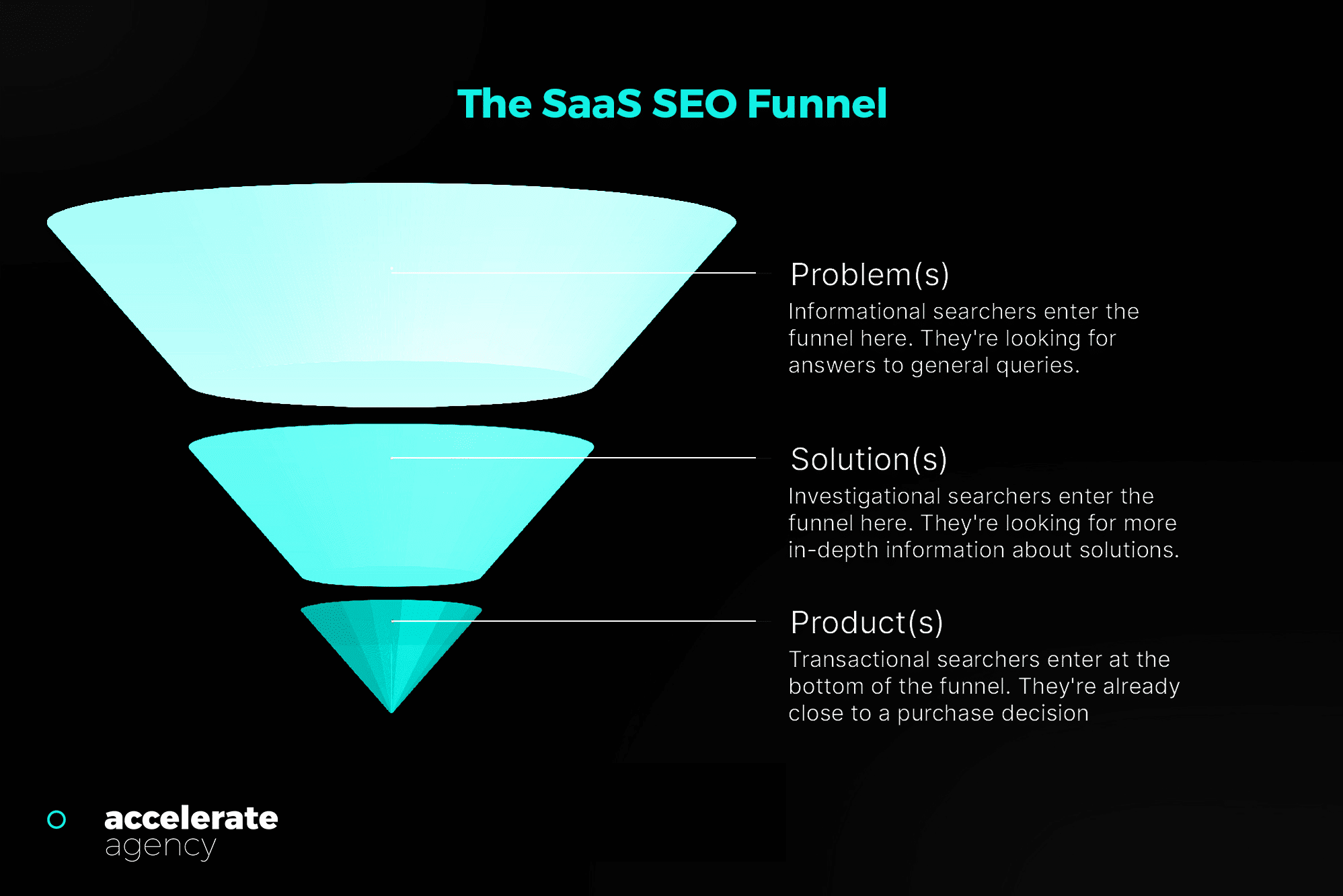
You might now be starting to see how this lines up with what we discussed about search intent. The different kinds of search intent, after all, fit within the sections of this SaaS SEO funnel.
An informational searcher is looking for solutions to a problem they have. Someone doing an investigational search compares specific products. They might read comparison guides, listen to podcast reviews, or reach out for free trials.
Don’t start the SEO process with the question ‘which search terms must we rank for?’. Instead, ask yourself, ‘who are our potential customers?’. Then, you can consider what they may search for and why. This is how to keep search intent at the front of your mind.
A tried and true way to better understand your target audience is to build buyer personas. These are fictional representations of your typical customers. They lay out the characteristics that people interested in your products are likely to share.
In the case of a SaaS brand, you’re likely to need more than one. Your different products or packages will appeal to varied clients, after all. Try to flesh out your personas as much as possible. There are a few different ways you can find useful information:
- Staff Interviews – Ask your team what they know or have noticed about your present customers.
- Customer Surveys – Get information straight from the horse’s mouth. Ask existing clients if they’d mind sharing some insights with you.
- Data – Your various solutions and platforms will already be packed with information. You can comb your CRM software for details on customer demographics. Google Analytics, meanwhile, can tell you plenty. It will reveal loads about how potential customers interact with your website.
With buyer personas, it’s easier to put yourself in the shoes of prospective customers. You’ll have a better idea of their pain points, and the problems they need solving. As a result, you’ll know the information they require.
Understanding the buyer’s journey.
People are a lot less predictable than water. That’s why the analogy of a funnel isn’t perfect for explaining their behavior. It’s also why you must endeavor to map buyer journeys before then lining them up with your marketing funnel. You don’t want to follow a template and assume that all customers take the same routes.
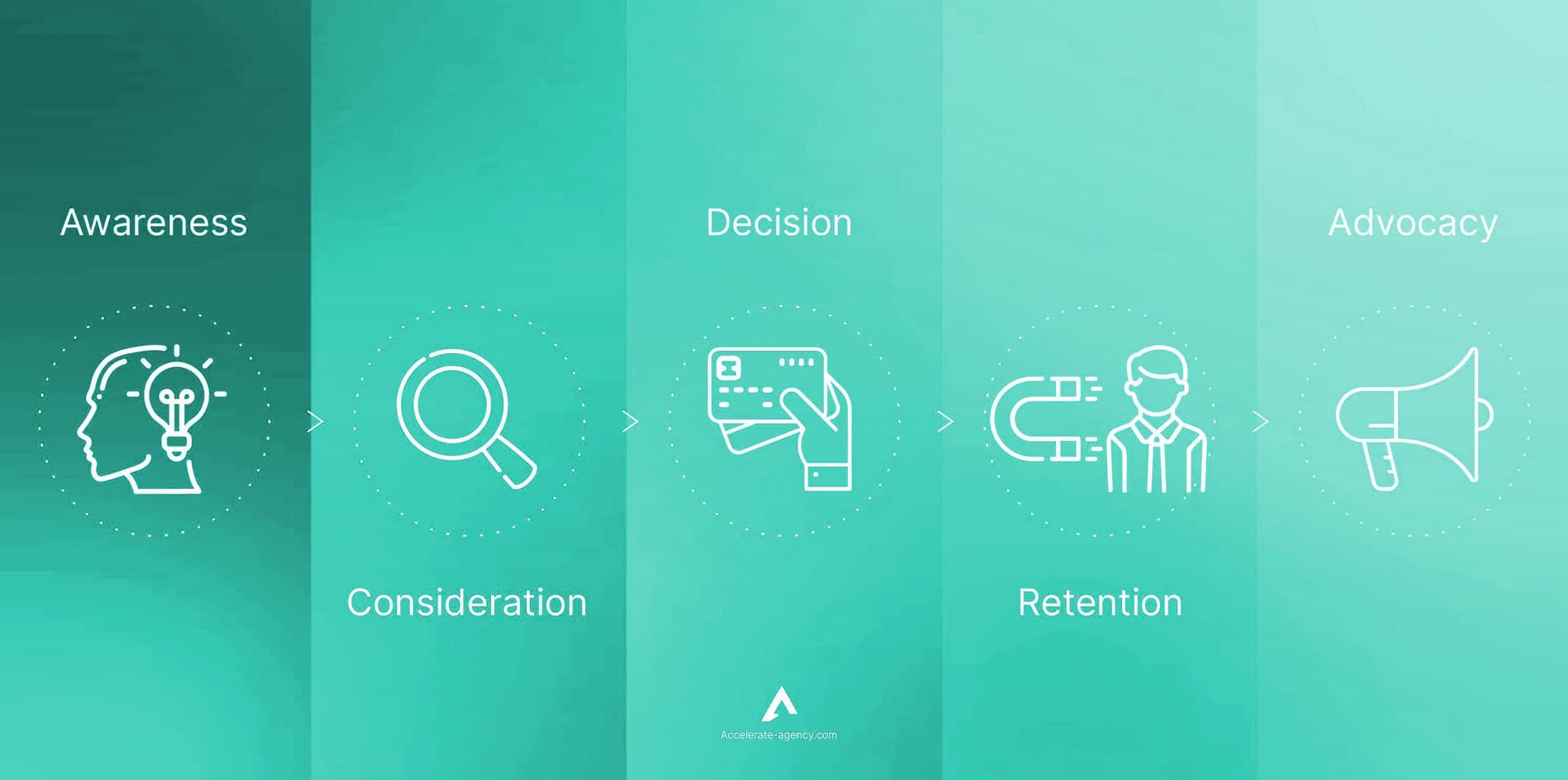
Some leads will enter your funnel at the top – they’re at the traditional ‘Awareness’ stage of their journey. These are the people most likely to perform informational searches. They’re aware of a problem or challenge and want to learn how to overcome that issue.
Other prospects, however, might first encounter your brand later along their journey. They may have learned about say, VoIP, through a LinkedIn contact or an in-person conversation with a colleague. It might be during further research – when doing investigative searches – that they find your firm.
Finally, some potential customers could jump into your funnel right at the bottom. They’ve completed much of their journey and already know the product that they need to solve their problem. All they’re searching for is the right provider.
Pre-Funnel SEO
Aptly – given the activity’s name – before we talk about SEO at each stage of your funnel, let’s address pre-funnel SEO. Many Scale-up and Enterprise SaaS brands engage in pre-funnel SEO, as it has a range of notable benefits. We’ll mention them a bit later, but first, let’s nail down what this part of SaaS SEO strategy is.
Pre-funnel SEO is when you target keywords and create content to attract a different audience. You’re not looking to snag visitors within your funnel. Instead, you’re reaching out to other persona-qualified traffic. By that, we mean people who match your buyer personas but may not presently want one of your products. They haven’t got a problem you can solve with your SaaS product, but are people you want to connect with.
HubSpot is a prime example of a SaaS brand that leans heavily on pre-funnel SEO. They have a comprehensive and renowned sales and marketing blog. It has great domain authority, and contains varied content that’s certain to interest the brand’s target audience.
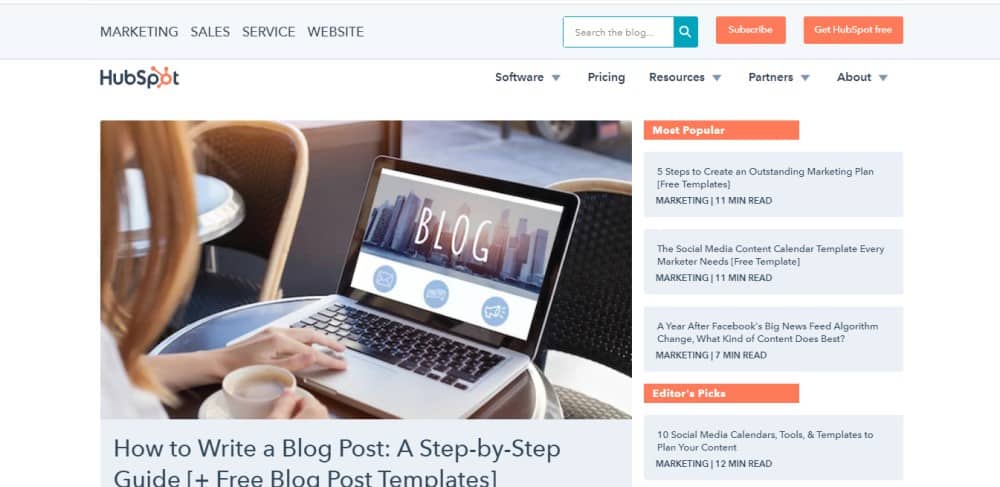
Far from all the posts, however, relate to HubSpot’s own products. Many of them focus on different areas of sales and marketing entirely. As such, they won’t rank for keywords relevant to the company’s marketing funnel.
What HubSpot knows, though, is that those posts will interest their target audience. As such, the traffic they bring does contain prospective customers. They’re just not ones who will convert in the short term.
There are many benefits to giving pre-funnel SEO a place within your wider SEO strategy:
- Brand Building & Awareness – By growing your persona-qualified traffic, you build your brand. You’re putting your name in front of people who are part of your target audience. That’s even if they’re not on a buying journey right now.
- Growing an Audience – Someone who isn’t a customer can still be a brand advocate. By creating and optimizing content beyond your funnel, you establish yourself as an authority in your field. Doing so can help you build an audience. Members of that audience may then recommend you to others who are interested in your products.
- Overcoming a Lack of Keywords – Depending on your product or niche, there may not be many relevant keywords to target. That limits your possibilities for SEO at any stage of your funnel. The pre-funnel alternative, therefore, is a way to grow your traffic nonetheless.
Top of the Funnel SEO
Not all SaaS sites will use pre-funnel SEO. A robust strategy, though, will always contain top of the funnel SEO. This is the work you put in to attract site visitors at the beginning of the buyer journey. You remember, it’s the traffic that will be entering your funnel by the traditional top-down route.
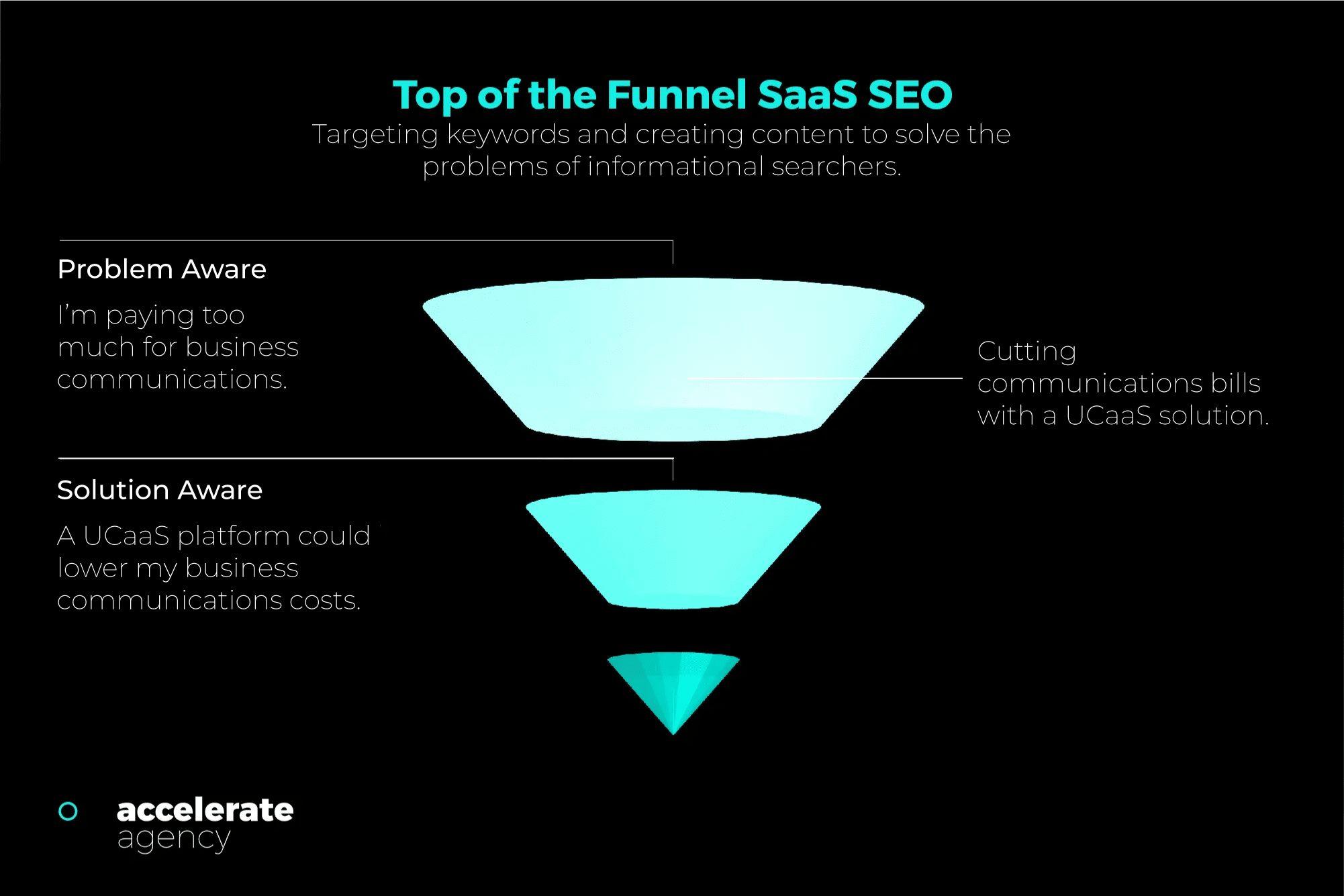
People entering the top of your funnel are aware of a problem or challenge they face. Say they feel they’re paying too much for their business communication solutions. If they don’t have any idea how to solve their issue, they’ll turn to Google. They might search for something like:
- ‘How to get cheaper business communications.’
- ‘How do I cut my commercial communication bills.’
- ‘How to get cheaper communication solutions for my small business.’
They’re trying to learn if there are solutions out there to the pain they’re suffering. This is your opportunity as a SaaS brand to create content that answers their search intent. If you know what potential customers want to know, tailor your content accordingly. You might create pages or posts which focus on:
- Cutting communications bills with a UCaaS solution.
- How unified communications platforms cut costs for small businesses.
- Replacing multiple providers with one UC specialist to shrink your bills.
Goals of top of the funnel SEO.
Buyers at the ‘awareness’ stage of their journey don’t often convert. They’re only just starting to grasp the problem they have and the solutions available to them. As such, your content strategy with top of the funnel SEO shouldn’t aim to immediately monetize the traffic you earn.
The following are the objectives to keep at the top of your mind:
- Attracting more traffic made up of visitors with a problem your products can solve.
- Providing those visitors with high-quality, detailed answers to the questions they’re asking.
- Introducing the idea of your products as a solution to their challenges.
- Engaging as many leads as possible. I.e., by getting them to join a mailing list, share contact details, or perhaps download a digital asset (ebook, etc.).
- Send site visitors further down your funnel. For example, link them to one of your product pages.
Keyword research: problem solving keywords.
We’ve touched on the type of content you need for top of the funnel SEO. It’s informational and educational material to help answer prospect’s questions. That will often take the form of blog posts. It can also, however, be pillar pages, FAQs, or other similar sections of your website.
This content must get optimized for the keywords that informational searchers are using. Your research in this area, then, has to focus on the problems those searchers have. Top of the funnel SEO is all about problem solving keywords.
The good news here is that you’ve already got a head start. You built your buyer personas earlier, which tell you your customer’s pain points. You know, therefore, the principal problems your target audience are seeking to solve.

You can arrange what you know simply and easily in a table like that shown above. Lay out the solutions you provide and the particular challenges they can solve. These should be the pain points you identified when building your buyer persona.
Those issues provide your jumping-off point for keyword research. Answering reader intent is critical. So, making sure your content stays tightly focused on the problems at hand is a must. It’s arguably more important than optimization for a particular keyword. You will, however, still want to ID and target search terms.
With your broad topics for content understood, this is more straightforward. Consider each challenge you’ve identified for your target audience. Then, brainstorm the phrases paramount to those issues. You can use any one of many tools to help with this stage of the process, too. Then, add the keywords to the final column of your table.
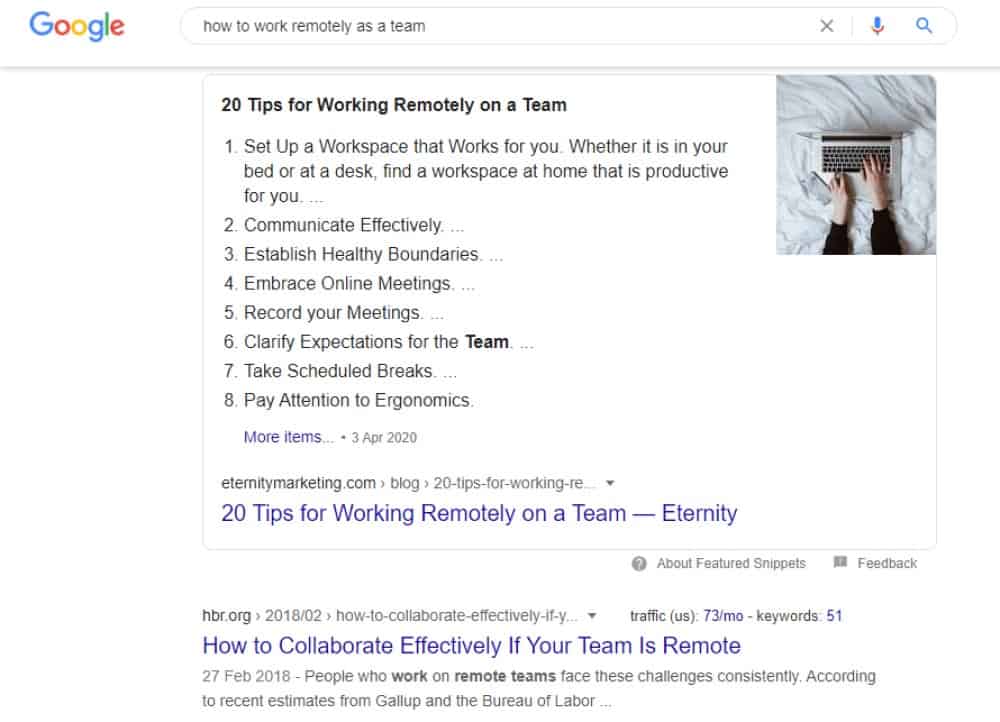
Middle of the Funnel SEO
Middle of the funnel SEO is particularly crucial to SaaS and other B2B brands. Buyer journeys in the niche are often lengthier than in the B2C world. You’re fairly likely to go online, find a book, skirt, or video game you like, and buy it all in one visit. You’re going to do a lot more research if you’re choosing a communications platform for your small business.
Your middle of the funnel content takes aim at the leads in their consideration phase. Here, your target audience is aware of both their problem and the available solutions to it. However, they haven’t settled on the tool or product they will choose to meet the challenge.
These searchers are still looking for information but of a more specific kind. General blog content won’t do – at this stage, they’re looking for different categories of products. More than that, they’re assessing those types of solutions against their unique needs. The SEO content you produce for this part of the funnel must align with those objectives.

Let’s extend our example of a firm worried about their business communications bills. At the middle of the funnel, they’re aware that a UCaaS platform might solve their problem. Now, they’ll be trying to find out more about those kinds of solutions. Things they may want to know will include:
- What features UCaaS platforms typically include.
- Whether solutions integrate with other software.
- If particular products are better suited to their industry or niche.
Say our fictional small business is in the financial niche. They might enter the middle of your funnel by searching for ‘UCaaS solutions for finance’. It’s those kinds of queries, therefore, that your middle of the funnel content must satisfy.
There is a range of broad content types to consider for this stage of your SaaS SEO strategy:
- Product Type Explainers – This may be a guide to or primer on a category of product. I.e., an ‘Ultimate Guide to UCaaS’.
- Product Type Comparisons – A page or post comparing different types of products. These could be all types you offer. They might be your product category as against your potential customer’s principal alternative. I.e., ‘UCaaS platforms Vs. On-Premises UC’.
- Industry Specific Guides – More targeted content to appeal to segments of your target audience from a particular niche. I.e., ‘UCaaS for Finance Businesses’, or ‘Communication Metrics to Monitor with UCaaS’.
- Feature Specific Guides – Pages or other material focusing on a specific feature of a product that a prospect may need. I.e., ‘UCaaS Platforms With Team Messaging’.
- Integration Explainers – Content detailing how a solution can work with other products. I.e., ‘Integrating a UCaaS Platform With Your CRM Software’.
- Use Cases – Pages or posts laying out a particular use of the type of product. I.e., ‘How to Use a UCaaS Platform to Improve User Experience’.
Goals of middle of the funnel SEO.
The traffic to the middle of your funnel doesn’t all come from one place. Some visitors may have moved down from the top. As mentioned earlier, though, traffic can also enter your funnel at the midpoint. Keep in mind, then, that your middle of the funnel content may be a prospect’s first point of contact with your brand.
Regardless of the source of the traffic, your mid-funnel SEO efforts have a few principal aims:
- To attract prospects already aware of potential solutions to their pain points.
- To add your tools to the range that they’re considering.
- To educate readers on features, benefits, and integrations of your categories of products.
- To introduce brand-new middle of the funnel traffic to your brand.
- To nurture leads and move them toward the bottom of the funnel.
Keyword research: product related keywords.
Keyword research for middle of the funnel SEO is mercifully straightforward. Once again, you’ll want to lean on your buyer personas.
This time, focus on different aspects of the personas. You’re interested in their niches and the types of products that may answer their pain points. You should also think about the features of those solutions they won’t be able to do without.

Once again, a straightforward table will help you visualize what you know. List out the features that are critical to your target audience. Then, also include the verticals or fields to which they’re most likely to belong.
It should be apparent how, armed with that information, you can ID keywords to target. You’re looking for search terms someone may use when looking for the type of mid-funnel content we discussed above.
From the above table, you can see you may choose to target sales teams. A feature they’d be interested in might be video conferencing solutions. A keyword like ‘Sales team video conferencing’, then, is an apparent target.

Bottom of the Funnel SEO
The leads at the bottom of your funnel are very different from those above. These potential customers know all about the types of solutions that could solve their problems. They’re also aware of the precise tools they have to choose from. Ideally, yours will be amongst those. It’s not a given, though, if a prospect joins your funnel here, rather than having traveled down from the top.

The people at this point of your funnel are close to their point of purchase. Your content here must attract these product-aware visitors and work to convert them. Here are a few general kinds of content to consider:
- Direct Comparisons – Content setting your product against those offered by direct rivals. Use the opportunity to highlight your USP and what makes your solution a better choice.
- Case Studies & Use Cases – Few things are better at convincing a lead than hard evidence of a product’s utility. Articles or posts detailing how your solution has helped existing clients are superb for the bottom of the funnel.
- Market Analysis & Industry Trends – Content discussing your broader niche will interest product-aware customers. They’ll want to know the state of the industry to help them select the right product.
- Product Tutorials or News – If a lead can learn how to use a solution before buying it, it will nudge them further toward a purchase. An article about a new solution or product update, too, is an excellent idea. It’s something a prospect weighing up their options is likely to click.
Goals of bottom of the funnel SEO.
When handling the bottom of the funnel aspect of your SEO strategy, you need to widen your focus. At this point, you’re looking to grow both traffic and conversions. Leads who’ve moved down the funnel and those who enter at the bottom are close to making a purchase decision.
Your goals when designing content for this stage of the process, then, are as follows:
- To attract product-aware traffic made up of visitors who are nearly ready to buy.
- To introduce your product to their decision-making process, if it’s not part of it already.
- To spotlight the strengths of your solution and show that it’s better than those of your rivals.
Keyword research: comparison & purchase keywords.
Your keyword planning at the bottom of the funnel involves a lot of competitor analysis. First, make a list of all the rivals offering directly competing products. These are the brands for which you can produce comparison content to extoll your product’s virtues.

Your next step is to ID brands offering slightly different products. These are tools that aren’t direct competitors to yours but which your target audience may opt to use instead. You can then build content that targets different types of keywords. Things like, ‘How to Choose the Right Business Communications Solutions’, or ‘Jive Voice competitors’.
A third table like that shown above will once again help to organize your research. It will help keep the content you produce and the keywords which it targets well-focused. You could even assign different writers or creatives to different competitors at this stage of the funnel. Whatever it takes to persuade those transactional searchers that you’re the brand for them.
You’ll also want to ID the correct search terms to target with your case studies that also form part of the bottom of the funnel content. A good starting point here is to think about the challenge you helped your client overcome. Perhaps you aided them in reducing call handling time.

The story of how, therefore, would be most interesting to prospects facing the same issue. You can then develop a list of keywords they’re likely to use. Such a selection may include things like ‘reduce call handling time with UCaaS’, etc.
06. Implementing SEO for SaaS
Up to now, we’ve dealt with each part of the SaaS SEO funnel separately. It was important to do so to highlight that your strategy must take each stage into account. Too many SaaS brands make the mistake of only looking to move traffic into the top of the funnel.
Each element of your SaaS SEO strategy, though, doesn’t happen in a vacuum. You want to make your efforts at every stage of the funnel part of a well-rounded overall plan. What you’ve generated through the above steps of our process means you’re well-placed to build one.
Your buyer personas tell you where down the funnel most of your target audience are likely to enter. That reveals which areas deserve most of your attention. You’ll also have a list of content topics and keywords for each section of the funnel. You need just one more thing before you can draw up your strategy.
What that final element is, is an understanding of your existing content. Audit your website and blog to check the subjects and keywords you’ve already got covered. Don’t forget to check the quality of technical SEO aspects too! ID pages that can get better optimized and others you may want to replace. Look at meta descriptions, image alt-texts, and other oft-forgotten details. Then, you can find the glaring gaps in your content compared with the topics and phrases you’ve IDed in your research.
With all that information now at your fingertips, you can build an SEO content creation strategy, including the following:
- Keywords to target at each stage of the funnel.
- General topics and subjects of interest to prospects at each stage.
- The types of content you need to produce for every area.
- Which parts of your funnel on which you should place more emphasis.
- Existing content that can get repurposed or optimized to fit your plan.
Find keywords to target at each stage of the funnel.
What are SEO keywords?
SEO keywords are the terms and phrases that make your page(s) show up in response to relevant search queries. They include single-word terms and long-tail keywords consisting of 3 or more words grouped together.
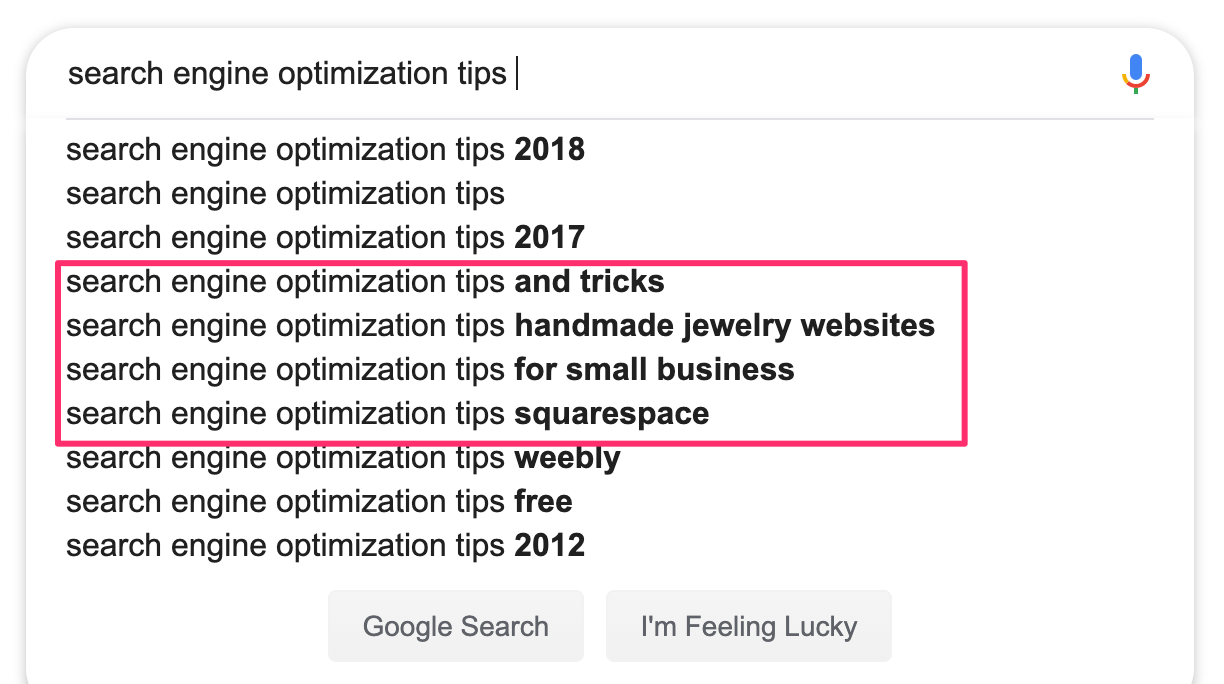
You’ll want to include keywords in every part of a blog post, web page, and/or article. That includes everything from the title to the subtitles and from any meta descriptions to, of course, the content itself.
Study general topics and subjects of interest to prospects at each stage.
We’ve all heard it before: knowledge is power. Arming yourself with more knowledge can only be a benefit that will allow you to grow your SaaS business.
One great way to do this is by ensuring that you’re studying relevant topics to prospects at every stage of your SEO journey. It’s good to know your facts on technical SEO; it’s even better to have both those facts and an understanding of what your audience wants under your belt.
Determine the types of content you need to produce for every area.
You can’t use one template for all your marketing and content channels.
It’s essential to tailor your content to the specific area it’s going to occupy – you wouldn’t expect to find short, viral videos on LinkedIn any more than you would head to TikTok for long-form discussions.
Decide which parts of your funnel on which you should place more emphasis.
This step is very specific to the details of your SaaS business. Is your software broadly helpful to many different types of people, or does it have specialized uses for particular groups of people? What does your target audience look like?
By considering these questions, you can start to pick out which parts of your funnel should receive more focus.
For example, if your platform works best when as many people as possible are using it, then the initial stages of the funnel should receive the most focus. An example of this is LinkedIn, which is based on the idea of building connections. This means that the more people that use it, the more connections users can make. The idea here would be to cast as wide a net as you can. Research existing content that can get repurposed or optimized to fit your plan.
It always helps when you don’t have to start entirely from scratch. That’s why it’s essential to consider which pieces of content you’ve already got available that can fit into your SEO plan.
Any SaaS company will, for example, have at least one web page dedicated to explaining how their software works. You can repurpose that content into a how-to guide that takes first-time users through the various features you offer. If that guide is also optimized to contain a bunch of relevant keywords, suddenly, you’ll be attracting tons of potential customers too.
When you’re considering which pieces of existing content you want to use, the most important thing is to do your research. This involves looking into relevant keywords, figuring out where you can organically incorporate lots of those keywords (vs. where that might be tough to do), and analyzing current trends.
Once you know what people are searching for, you can use your content to match those trends. If everyone’s searching for pieces that use case studies, and some of your existing content fits that description, you should consider repurposing that piece.
07. Technical SEO for SaaS
Technical SEO is an essential part of any SaaS SEO strategy. It involves optimizing the technical aspects of your website to improve its visibility and ranking in search engine results pages (SERPs).
There is no overarching trick or secret that will ensure your SaaS website has “perfect” technical SEO. However, implementing a combination of various strategies can greatly enhance your website and put you ahead of the competition.
Some key technical SEO strategies to include in your overall strategy for SaaS include optimizing site structure, improving page speed, making your site mobile-friendly, securing it with HTTPS, creating and submitting an XML sitemap, managing duplicate content, and optimizing for voice search. By nailing these technical elements, you’ll create a solid foundation for your SaaS website, and improve your chances of ranking well in the SERPs.
Let’s break this down:
- Optimizing site structure – Optimizing site structure involves making your website easy to navigate with clear headings, tags, and meta descriptions for each page.
- Improving Page Speed – Improving page speed includes optimizing images and code, and using a content delivery network (CDN) to speed up loading times.
- Making your site mobile-friendly – Making your site mobile-friendly involves using responsive design and ensuring your pages load quickly on mobile devices.
- Securing your site with HTTPS – Securing your site with HTTPS encryption will increase security and improve your search engine rankings.
- Creating and submitting an XML sitemap – Creating and submitting an XML sitemap will make it easier for search engines to find and index your content.
- Managing duplicated content – Managing duplicated content by using rel=canonical or redirects will prevent search engines from indexing duplicate versions of your pages.
- Optimizing for Voice Search – Optimizing for voice search involves including long-tail keywords, natural language phrases, and structured data on your site.
08. Link Building for SaaS SEO
While not covering every nuance of SaaS SEO, what you’ve learned so far about both the technical and content aspects of SEO will put you in a good position to create a solid strategy for your SaaS business. By focusing on creating high-quality, optimized content and addressing any technical SEO issues on your website, you can set yourself on a path towards dominating the SERPs. However, you won’t get your ranking up with that alone.
Google takes lots into account when ranking websites. The on-site content plays a big part but doesn’t cover every base. One thing you must build into your strategy alongside content creation is link building. Even the highest quality, best-optimized pages won’t rank with no backlinks.
It’s true that people will naturally want to link to outstanding content. You can’t, however, adopt a ‘build it and they will come’ attitude. You must at least get the ball rolling with some active outreach. Yes, horror of horrors, that does mean asking for some links.
Take the SaaS brand, Canva, as an example. They have a remarkable SaaS SEO track record, and building backlinks is a big part of why. In fact, according to ahrefs, the brand has over 14m of them. ! That’s thanks to a shared focus on great content and personalized outreach.
Canva employs SEO specialists devoted to growing traffic. Part of their job descriptions is to earn backlinks for the brand’s content. They do so by first identifying blog posts, pages, or other material relevant to their niche. Then, they reach out to the writers or owners of the content to request they include a Canva link.
You may not be able to employ your own SEO specialist. This kind of organized, sensible outreach, though, can – and should – be part of your SaaS SEO strategy. Just make sure to follow these examples of best practice for SaaS link building:
- Approach Your Network First – Firms or professionals you already have a relationship with are more likely to want to work with you. Reaching out to them can provide some low hanging fruit for link building.
- Leverage Integrations – Does your product integrate with third-party solutions? If so, ask the brands behind those tools if they might link to your content. You’re likely to be writing about the integrations for your lower funnel content, after all.
- Stay Relevant – Eventually, you’ll cast your net wider for backlinks. Don’t adopt a scattergun approach, though. Links are only valuable if they come from a domain relevant to your content, product, niche. Preferably, you could find sites to suit all three.
09. Maximizing your Strategy: The best SEO SaaS Software & Tools to implement in 2023
The implementation of SaaS-based SEO software and tools can be incredibly beneficial when developing an SEO strategy for your SaaS company. These tools can provide a wealth of information about your website’s performance, the preferences of your audience, and the actions of your fellow competitors in the SERPS.
By utilizing these tools, you can make informed, data-driven decisions that will allow you to enhance your search engine rankings, attract relevant traffic, and improve conversions – all whilst ensuring you stay ahead of the competition.
There are thousands of great SaaS SEO platforms out there that you can easily implement into your SEO strategy today. However, here are a few of the best-rated SEO tools for SaaS that I would personally recommend for optimum growth and success:
Ahrefs:
- Provides a comprehensive analysis of your backlink profile, which is crucial for understanding the quality and quantity of links pointing to your website.
- Allows you to track your keyword rankings, so you can monitor your progress and identify areas where you need to improve.
- Offers a content analysis tool, which can help you optimize your website’s content for search engines by providing suggestions for improvement.
Google Search Console:
- Gives you insights into how your website is performing in search results, including the number of clicks, impressions, and average search position.
- Alerts you to any crawl errors on your website, so you can fix them and ensure that all pages are being properly indexed by Google.
- Allows you to submit your sitemaps, which makes it easier for Google to discover and index all of your pages.
SEMrush:
- Offers a comprehensive suite of SEO and PPC tools, including keyword research, competition analysis, and search engine ranking tracking.
- Helps you analyze your competition by providing insights into their keyword rankings, backlink profile, and advertising strategies.
- Provides a keyword magic tool that makes it easy to find profitable keywords to target in your SEO strategy.
Conclusion
For a SaaS firm, growing online traffic is fundamental to success. The more people you can make aware of your brand and products, the better. A robust SEO strategy is the foundation on which you can build that success. Get your SEO correct, and your other acquisition efforts will also improve.
Getting SaaS SEO right takes time, effort, and investment, but is well worth it. What you must remember throughout is to tailor your work to your potential customers. That starts with understanding who your target audience is. You must then build on that by mapping your buyer’s journey.
From there, you can segment your SaaS SEO funnel to target leads at different stages of that journey. Research what your prospects want, and create optimized content to suit. Make sure to consider searcher intent throughout. Every page or post you build must answer the questions or aims of its targeted readers.
Even the best content needs backlinks to help it rank. That means organized outreach should also play a role in your SaaS SEO. Approaching domains or brands for links can feel daunting. If you’ve got your content creation right, though, it’ll be easier than you think. Writers, editors, and business owners are keen to link to top-class content. It helps their domain as well as yours.
So, there you have it. Everything you could possibly want to know about building the perfect SEO strategy for your SaaS business in 2023, and probably a fair bit more to boot. If that’s whetted your appetite and you do want to learn more about scaling your SaaS brand then book a chat with us.
